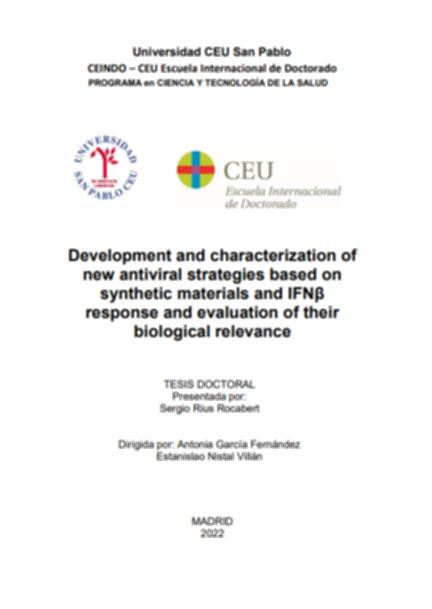Please use this identifier to cite or link to this item:
http://hdl.handle.net/10637/13792Development and characterization of new antivir and FNβ response and evaluation of their biological relevance.

See/Open:
Development_Rius_2022.PNG
59,19 kB
image/png
See/Open:
Development_Sergio_Rius_USPCEU_Tesis_2022.pdf
Until 2025-06-10
6,31 MB
Adobe PDF
Request a copy
| Title: | Development and characterization of new antivir and FNβ response and evaluation of their biological relevance. |
| Authors : | Rius Rocabert, Sergio |
| Keywords: | Virus.; Interferon.; Antiviral.; STING.; ISG.; Metabolismo.; Viruses.; Interferon.; Antiviral.; Metabolism.; Influenza. |
| Abstract: | Los virus constituyen un constante desafío para los sistemas sanitarios a nivel mundial por la cantidad de muertes que producen anualmente, por su carácter emergente y ser potenciales causantes de pandemias. El desarrollo de estrategias antivirales de amplio espectro capaces de combatir estos patógenos se presenta como una buena opción para reducir los efectos eventos actuales y futuros. La identificación de nuevos agonistas de mecanismos antivirales naturales, como el interferón, así como la descripción de materiales antivirales se presentan como alternativas prometedoras. Este trabajo desarrolla una descripción de las propiedades antivirales de dos materiales distintos, basados en vidrios y arcillas capaces de eliminar diferentes virus con relevancia clínica de una forma eficaz y rápida. También se describe la inducción de interferón por agonistas alternativos, como la thapsigargina, explorando el mecanismo de activación y su relevancia en la producción de un estado antiviral. Se desarrolla un nuevo método para cuantificar interferón centrado en su actividad biológica que se aproxima mejor a la definición de unidad de interferón. Por último, se realiza un estudio de las alteraciones metabólicas producidas en monocitos humanos en las etapas tempranas de la infección con gripe en el contexto de la expresión o no de interferon. Viruses represent a constant challenge for worldwide health systems due to the number of deaths that cause annually, being the major amount of emerging pathogens and potential pandemic agents. The development of broad antiviral strategies able to fight these pathogens is seen as an interesting option to minimize the effects of present and future events. The identification of new agonists of natural antiviral mechanisms, such as interferon system, as well as the development of antiviral materials are promising approaches to accomplish that. In this work, a description of the antiviral properties of two kinds of different materials, based on glass and clay, is described. These materials are capable to eliminate different viruses with clinical relevance. The description of the induction of interferon by novel agonists, such as thapsigargin, including an exploration of the mechanism and the relevance of the antiviral induction is also performed. A new method to quantify interferon by its biological activity fitting better the definition of interferon unit is developed. Finally, a study of metabolic alterations in human monocytes in the early stages of influenza virus infection is performed in the context of the production of interferon or its inhibition. |
| Description: | Tesis-CEINDO, Universidad San Pablo CEU, Facultad de Farmacia, Programa en Ciencia y Tecnología de la Salud, leida el 10 de junio del 2022 |
| Director(s): | Olmo Izquierdo, Nuria del Ruíz Gayo, Mariano |
| URI: | http://hdl.handle.net/10637/13792 |
| Rights : | http://creativecommons.org/licenses/by-nc-nd/4.0/deed.es |
| metadata.dc.date.endEmbargo: | 2025-06-10 |
| Issue Date: | 11-Jun-2022 |
| Center : | Universidad San Pablo-CEU |
| Appears in Collections: | Ciencia y Tecnología de la Salud |
Items in DSpace are protected by copyright, with all rights reserved, unless otherwise indicated.

